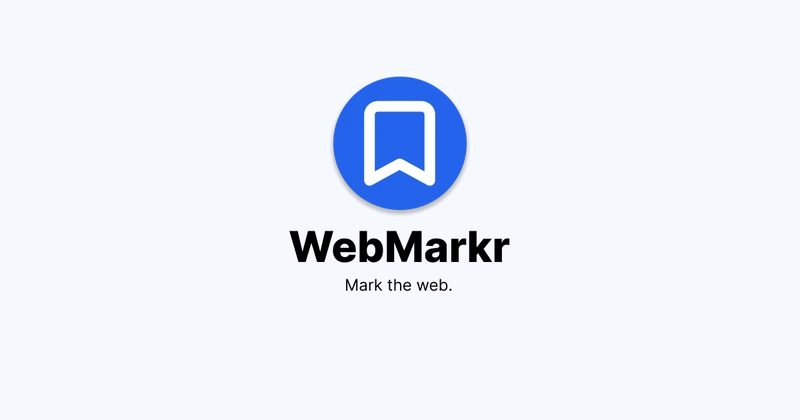A few days ago, I set myself a challenge: build a functional web bookmarking tool in just 2 hours. The result? WebMarkr—a minimal yet powerful bookmarking site that runs entirely in the browser using Next.js, TailwindCSS, and shadcn/ui.
This project turned out to be a fun and productive way to explore how quickly core functionality can be implemented while keeping the user interface clean and efficient. In this article, I'll walk you through the process, share some key insights, and discuss where I envision WebMarkr heading next.
🛠 Tech Stack & Features
Tech Stack
- Next.js – Chosen for its fast performance and built-in server-side rendering capabilities.
- TailwindCSS – Utilized for rapid styling and building a clean, responsive design with utility classes.
- shadcn/ui – Provided prebuilt, accessible, and modern UI components, which accelerated the development process.
- localStorage – Enabled seamless persistence of bookmarks without the need for a backend.
Core Features
- Bookmark Creation: Quickly save URLs along with titles to keep your favorite sites organized.
- Instant Search: Find saved bookmarks in real time with a responsive search feature.
- Tagging & Categorization: Organize bookmarks with tags and categories, making retrieval easier.
- Dark Mode: An accessible design choice to cater to users who prefer low-light environments.
- Edit & Delete: Fully manage your saved links, with intuitive options to update or remove entries.
- Client-Side Only: With no authentication or backend required, the experience is streamlined and efficient.
🏗️ Development Process
1. Project Setup
Starting with a Next.js template provided a solid foundation, allowing me to focus on the functionality rather than boilerplate code. I quickly integrated TailwindCSS for styling and brought in shadcn/ui for pre-styled components. This setup significantly reduced the overhead usually associated with design and layout decisions.
2. Leveraging Local Storage
I aimed for a frictionless user experience where signing up or managing an account wasn’t necessary. Using localStorage to persist bookmark data allowed me to create a robust client-side experience. This approach meant:
- Instant data retrieval on page load.
- No waiting time for API calls or server responses.
- A completely self-contained application ideal for rapid prototyping.
3. Building the Core Features
The focus was on three main functionalities:
-
Adding Bookmarks: A simple form captures the title and URL, storing them in
localStorage. - Searching Bookmarks: Implemented a responsive search bar that filters bookmarks in real time.
- Managing Bookmarks: Easy-to-use edit and delete options ensured that users could quickly adjust their saved links.
The goal was to ensure that every interaction was as intuitive as possible, even within a tight development window.
4. Crafting the User Interface
TailwindCSS played a crucial role in achieving a minimalist design with maximum usability. I adopted a “less is more” philosophy:
- Clear typography and spacing to enhance readability.
- A color scheme that balanced vibrancy and simplicity.
- A layout that adapts seamlessly across devices, ensuring a responsive user experience.
The combination of shadcn/ui and Tailwind allowed for rapid prototyping without sacrificing quality or accessibility.
🔥 Challenges & Learnings
Time Constraint
Working within a 2-hour window was both exhilarating and challenging. It required:
- Making swift decisions about feature inclusion.
- Prioritizing essential functionality over perfection.
- Embracing iterative improvements rather than a perfect first draft.
State Management
Handling UI updates efficiently was a key learning point. Since all data was managed through localStorage, ensuring that state changes were reflected promptly in the UI was crucial. This experience reinforced best practices for managing client-side state in Next.js applications.
Embracing Minimalism
Keeping the app lightweight and free from unnecessary features not only improved performance but also underscored the importance of user-centric design. Sometimes, less truly is more.
🚀 Future Improvements
While WebMarkr currently delivers a solid bookmarking experience, there’s a clear roadmap for making it even more powerful:
- Cloud Sync & Multi-Device Support: Integrate with a backend service (such as Firebase or Supabase) to allow users to sync bookmarks across devices, ensuring data persistence beyond the local browser.
- AI-Powered Bookmark Organization: Implement machine learning algorithms that analyze user behavior to suggest optimal categorization, relevant tags, or even recommend related bookmarks.
- Web Page Previews & Summaries: Integrate with an API to automatically generate previews or concise summaries of bookmarked pages, enhancing the user’s ability to decide which bookmarks to revisit.
- Keyboard Shortcuts & Quick Actions: Boost productivity by enabling keyboard navigation and shortcuts for adding, searching, and managing bookmarks without relying on mouse interactions.
- Browser Extension: Develop a dedicated Chrome/Firefox extension for one-click bookmarking, allowing users to save links instantly as they browse.
- User Analytics & Insights: Offer users insights into their bookmarking habits, such as most visited categories or usage trends, adding an analytical layer to the experience.
🎯 Conclusion
WebMarkr is more than just a quick project—it’s a demonstration of what can be accomplished in a limited time when you have the right tools at your disposal. By harnessing the power of Next.js, TailwindCSS, and shadcn/ui, I was able to build a minimal yet robust bookmarking app that emphasizes functionality and user experience.
The journey was packed with learning opportunities, from effective state management using localStorage to making design decisions under tight deadlines. As I look ahead, there’s plenty of room to expand WebMarkr into a more feature-rich platform that leverages both modern technologies and innovative ideas.
If you’re curious to try it out or have suggestions on how to push WebMarkr further, I’d love to hear your thoughts in the comments. Let’s keep building, iterating, and pushing the boundaries of what we can create in record time!
Happy coding! 🚀

